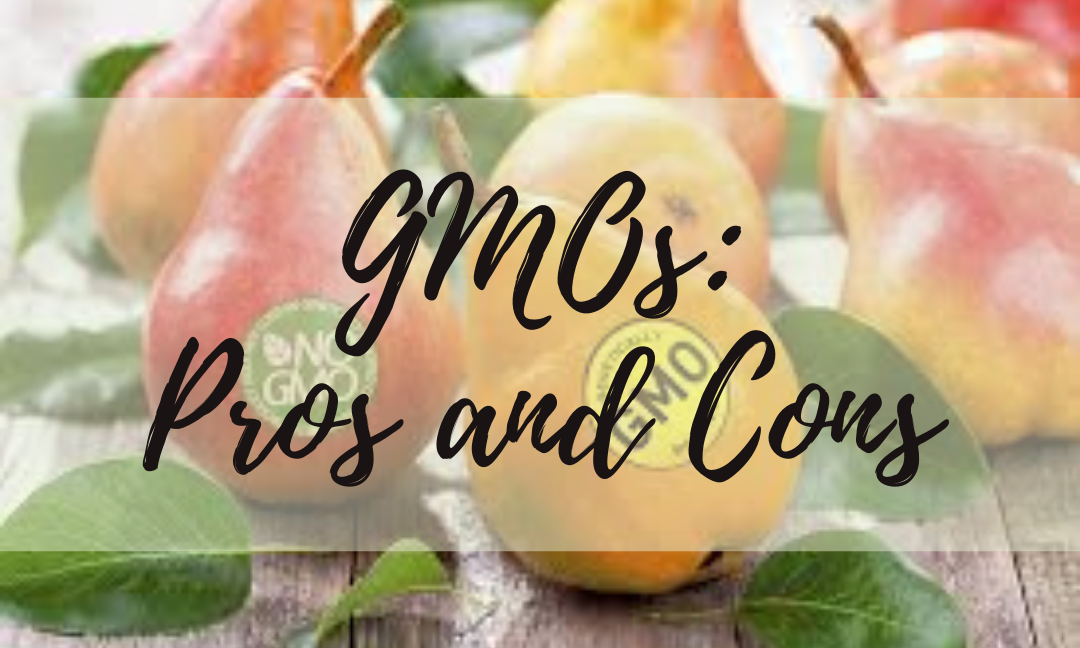Written by: Emily Sheng
The term GMO is something you’ve likely heard of, but you may not necessarily know what it means. Perhaps you’ve heard of them being these crazy things scientists cook up in a lab that benefit society greatly, or something one should avoid when checking produce labels. With so much information in the world, it’s hard to figure out whether they are good or bad, or maybe a bit of both. This cloud of mystery surrounding GMOs will dissipate as we take a closer look at the definition of GMOs and what they do for our society and environment.
 GMOs, or genetically modified organisms, are organisms that have had their genetic code artificially modified by humans, creating a range of genes that do not naturally exist in the world. This is done by inserting a specific gene into a cell’s DNA and then allowing that cell to grow and reproduce until it turns into the intended organism. They can be a range of living things such as plants, animals, and bacteria. GMOs are used for scientific research and medicinal purposes, but they can most commonly be seen in the plants we eat.
GMOs, or genetically modified organisms, are organisms that have had their genetic code artificially modified by humans, creating a range of genes that do not naturally exist in the world. This is done by inserting a specific gene into a cell’s DNA and then allowing that cell to grow and reproduce until it turns into the intended organism. They can be a range of living things such as plants, animals, and bacteria. GMOs are used for scientific research and medicinal purposes, but they can most commonly be seen in the plants we eat.
Many crops around the world are genetically modified to withstand the things that prevent a good yield, such as pests, weeds and diseases. In Canada, genetically modified alfalfa, canola, corn, potatoes, soybeans, and sugar beets are commercially grown. Some plants are genetically modified to fight off certain insects, which means they have fewer pesticides, while others are modified to tolerate doses of insecticides or herbicides. This is beneficial to farming companies because not only does it allow them to be able to yield more crops, but it makes the nurturing of the crops less expensive as they don’t have to spend as much on insecticides and herbicides. This is beneficial because less pesticide use is better for human health and the ecosystem. For consumers, GMO foods tend to be less expensive than non-GMO foods since they are cheaper and more efficient to grow.
 While GMOs seem like the perfect solution to all problems, there are other negative effects that are not as visibly seen. There is always a risk when it comes to introducing artificial things into a natural environment. These genetically engineered genes can spread, introducing new traits and advantageous properties to different organisms and ecosystems. This can cause negative consequences on local species and can disrupt the balance of nature. The food chain and the survival of other species may be affected, as these crops are designed to be resistant to most of their predators. Weeds and pests can evolve into “superweeds” and “superpests” that are even more resistant to herbicides and pesticides. The first case in Canada was reported in Nova Scotia, 2019, where farmers have found that the insect, European Corn Borer, had become resistant to the genetically engineered traits of GM crops.
While GMOs seem like the perfect solution to all problems, there are other negative effects that are not as visibly seen. There is always a risk when it comes to introducing artificial things into a natural environment. These genetically engineered genes can spread, introducing new traits and advantageous properties to different organisms and ecosystems. This can cause negative consequences on local species and can disrupt the balance of nature. The food chain and the survival of other species may be affected, as these crops are designed to be resistant to most of their predators. Weeds and pests can evolve into “superweeds” and “superpests” that are even more resistant to herbicides and pesticides. The first case in Canada was reported in Nova Scotia, 2019, where farmers have found that the insect, European Corn Borer, had become resistant to the genetically engineered traits of GM crops.
GMOs can also affect biodiversity and food security. In nature, it is the biodiversity of an ecosystem that allows the survival of species. Since there are more types of organisms, there is a better chance that some will survive if there is a sudden change in climate or environment. However, because GM crops have the same genes, that means that one specific disease can wipe out the entire crop. This is a big issue in food security, and many people could go hungry. GMOs are also time-consuming and expensive, and they allow big companies to take control of the seed market. GM crops are patented and their seeds are expensive to purchase, so they put local and small farmers at a financial risk. There will be more dependence on these big companies, and therefore they will have more control over the food supply.
Genetically modified crops are often viewed as beneficial, but many more see them as a pathway for more problems. Regardless of what they are, one can agree that they are a big change for the world. It’s up to you to decide whether it’s a positive change or a negative one.
References
- (n.d.). Retrieved from https://ag.purdue.edu/GMOs/Pages/The-Science-of-GMOs.aspx
- Acker, R. V., Rahman, M. M., & Cici, S. Z. (2017, October 26). Pros and Cons of GMO Crop Farming. Retrieved from https://oxfordre.com/environmentalscience/view/10.1093/acrefore/9780199389414.001.0001/acrefore-9780199389414-e-217
- Environmental Impacts. (2019, June 18). Retrieved from https://cban.ca/gmos/issues/environmental-impacts/
- First Canadian Case of Insect Resistance to Genetically Engineered Corn Discovered. (2019, June 11). Retrieved from https://cban.ca/first-canadian-case-of-insect-resistance-to-genetically-engineered-corn-discovered/
- GMO and non-GMO: Pros and Cons. (2021, January 27). Retrieved from https://www.proterrafoundation.org/news/gmo-and-non-gmo-pros-and-cons/
- Kennedy, M., & Cassetty, S. (2020, November 20). Evidence-based pros and cons of GMO foods. Retrieved from https://www.insider.com/gmo-pros-and-cons
- O’Hara, E. (2019, September 30). What Foods in Canada are Genetically Modified? CropLife.ca. Retrieved from https://croplife.ca/field-notes-gmo-foods/
- Pocket K No. 4: GM Crops and the Environment. (n.d.). Retrieved from https://www.isaaa.org/resources/publications/pocketk/4/default.asp
- Why we are against GMOs – GMOs. (2018, January 12). Retrieved from https://www.slowfood.com/what-we-do/themes/gmos/why-we-are-against-gmos/
- Says:, A. L., Says:, H. L., Says:, L., Says:, S. B., Says:, S., Says:, B., . . . *, N. (2015, August 12). Challenging Evolution: How GMOs Can Influence Genetic Diversity. Retrieved from https://sitn.hms.harvard.edu/flash/2015/challenging-evolution-how-gmos-can-influence-genetic-diversity/
Image references
- https://vertassets.blob.core.windows.net/image/94ef8355/94ef8355-cbf9-43f0-98e1-db7f861138e3/gmo_tomato_injection.jpg
- https://encrypted-tbn0.gstatic.com/images?q=tbn:ANd9GcRteA8qqvncomxWQjWYEZg3eQUl6rlpGsCvEA&usqp=CAU

